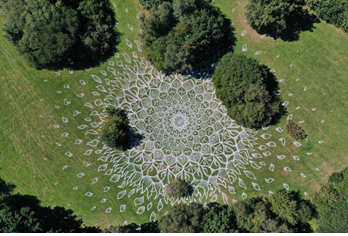

25th August 2022 (6 Topics)
Context
Some residents of Liverpool in the UK are marvelling over a mandala art the size of one and a half football pitches in length created by artist James Brunt with materials such as leaves and rocks.
About
About Mandala Art:
- Mandala literally means “circle” or “centre” in Sanskrit. It is defined by a geometric configuration that usually incorporates the circular shape in some form.
- A mandala is a spiritual and ritual symbol in Asian cultures.
- Origin of Mandala Art:
- It is believed to be rooted in Buddhism, appearing in the first century BC in India. Over the next couple of centuries, Buddhist missionaries travelling along the Silk Road took it to other regions.
- In Hinduism, the mandala imagery first appeared in Rig Veda(1500 – 500 BCE).
- Meaning of Mandala motifs:
- In Hinduism and Buddhism, the belief is that by entering the mandala and proceeding towards its center, you are guided through the cosmic process of transforming the universe from one of suffering into one of joy and happiness.
- In Hindu philosophical systems, a mandala or yantra is usually in the shape of a square with a circle at its centre.
- A traditional Buddhist mandala is a circular painting that is meant to help its creator discover their true self.
Symbolism in Mandalas
Some common symbols within the mandala include:
- Wheel with eight spokes:The circular nature of a wheel works as an artistic representation of a perfect universe. The eight spokes represent the Eightfold Path of Buddhism, a summary of practices that lead to liberation and rebirth.
- Bell: Bells represent openness and emptying of the mind to allow the entrance of wisdom and clarity.
- Triangle:When facing upward, triangles represent action and energy, and when facing downward, they represent creativity and the pursuit of knowledge.
- Lotus flower:A sacred symbol in Buddhism, the symmetry of a lotus depicts balance. As a lotus reaches up from underwater into the light, so too does a human reaching for spiritual awakening and enlightenment.
- Sun: A popular basis for modern mandala patterns, suns tend to represent the universe, often carrying meanings related to life and energy.
Mandala in modern Indian art
- The mandala, which has its roots in ancient philosophy, has taken on many different forms thanks to modern and contemporary Indian artists.
- While it still appears in Thangka paintings, mainstream artists connected to the tantric and neo-tantric spiritual movements prioritise it in their work.
- As part of art therapy, participants are encouraged to create and colour mandalas. Studies have also been conducted to understand if mandalas can help reduce stress.
More Articles

